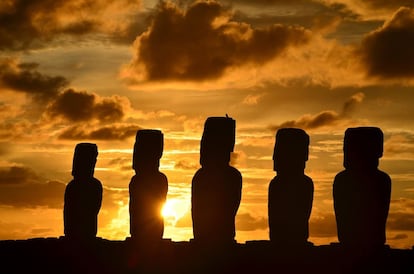
DNA suggests that the Rapa Nui arrived in the Americas two centuries before Columbus
The study of 15 ancient corpses debunks the myth of the collapse of Easter Island due to overexploitation
DNA extracted from 15 corpses stored in a Paris museum has yielded a monumental surprise: the Rapa Nui, inhabitants of Easter Island, the most isolated place on Earth, reached the Americas by sailing two centuries before the caravels captained by Christopher Columbus. The study provides a mind-blowing twist to the history of the tiny territory lost in the immensity of the Pacific. To the east, Easter Island is more than 3,500 kilometres (2,175 miles) from Chile, the country to which it belongs. In the opposite direction, the nearest land is the Pitcairn Islands, 1,900 kilometres (1,180 miles) away.
The first inhabitants of Easter Island were originally from Polynesia, from where they are believed to have arrived by boat around the year 1200 A.D. From that moment on, and without anyone quite knowing how, the Rapa Nui carved, transported and erected more than 900 moai, imposing human torsos that reach 10 metres in height and weigh 80 tons. DNA analysis of current members of the Rapa Nui shows that they are 90% Polynesian and 10% American. But, in 2017, the study of the remains of Rapa Nui who had lived centuries ago found no trace of American DNA, adding to the mystery.
Since 2014, Víctor Moreno-Mayar, a Mexican evolutionary anthropologist, has been studying the origin and history of the Rapa Nui. It is a difficult task, as the island community does not allow the analysis of remains of ancestors buried on the island. Moreno-Mayar’s team found a unique opportunity in boxes containing bones of supposed Rapa Nui collected by French sailors in the 19th century, which were stored in the National Museum of Natural History in Paris.
The results, published Wednesday in Nature, confirm that all of them were originally from Easter Island and lived between 1670 and 1900. Their genetic profile shows 90% Polynesian DNA and 10% American, which supports previous, smaller studies by the same team.
Whenever two people have children, their genome is split into portions and recombines, like shuffling a deck of cards. “Since we know this biological process, we can see the lengths of these blocks of American DNA and ask when they entered the Polynesian population of Rapa Nui,” Moreno-Mayar, who is currently working at the University of Copenhagen in Denmark, told this newspaper. In addition, these blocks can indicate the date when the Rapa Nui and Native Americans met and had children. “The shorter, the older the interbreeding event” and vice versa, explains the Mexican geneticist. His team’s calculations suggest that interbreeding between Polynesians and Native Americans first took place around 1300 A.D., approximately two centuries before the three vessels sent by Spain’s Catholic Monarchs and captained by Columbus reached the Caribbean coasts of the Americas in 1492, and four centuries before Europeans discovered Easter Island, in 1722.

DNA does not clarify whether it was the Rapa Nui who reached the Americas or vice versa, but the former is more plausible, Moreno-Mayar’s team reasons, given the Polynesian people’s skill at navigation, often heading east and against the wind. In less than a century, the Polynesians managed to reach Easter Island and from there, the shores of South America, an astonishing achievement that leaves many questions open.
The genetic material recovered in Paris is not enough to determine how many Rapa Nui reached the Americas, or whether there were one or more arrivals. Nor, of course, what their boats were like. The data only indicate that they crossed paths with inhabitants from the west of the Andes; it is impossible to be more specific.
A navigation experiment determined that a vessel similar to the one used by the inhabitants of Easter Island to travel toward the continent would have reached the coasts near Guayaquil in Ecuador, explains Moreno-Mayar. “We have no DNA from this region, neither current nor ancient, because this molecule degrades over time, and the worst conditions for its preservation are heat and humidity,” he explains. Finding the “mirror population” of the Polynesian pioneers, descendants of these crossbreeding events, with 90% American DNA and 10% Polynesian, is a very difficult task, due in part to the fact that in South America there is much less population genetic data than in Europe or the United States.
The next step in the investigation is to obtain permission from the French government to repatriate the remains of the 15 Rapa Nui analyzed, which were collected by the explorer and ethnologist Alphonse Pinart around 1870. Until the study was carried out, these bones were stored and labelled, but without much further information about their origin, explains Moreno-Mayar. Throughout their work, the team has collaborated with the Rapa Nui community, which has launched a program to recover its ancestors stored in Western museums. For now, the Parisian museum has not received any requests for these remains, according to a spokesperson for the institution, who points out that, according to French law, it should be the Chilean government that requests the recovery and the French government that decides whether it is granted.
The myth of collapse
The study also debunks the theory that the Rapa Nui culture collapsed before the arrival of Europeans due to overexploitation of the island, wars, epidemics, and even cannibalism. The first European navigators who arrived on Easter Island — first the Dutchman Jacob Roggeveen, on Easter Day 1722, hence the Western name for the island, and then the Spanish captain Felipe González de Haedo in 1770, who drew a detailed map and located the moai — could not believe how a people who did not know of the wheel or metals, and who numbered only a few thousand, could have created such colossal sculptures. The idea that Easter Island had a prosperous past, with a population of around 15,000, only to be decimated by deforestation and resource abuse around 1600, later gained traction. Despite scant archaeological evidence, the narrative was championed by influential anthropologists such as Jared Diamond, who dedicated his book Collapse to the theory, in which he spoke of “ecocide,” as if these societies were to blame for their own destruction. The Rapa Nui became a perfect metaphor for the dangerous excesses of human beings in the face of climate change.

The 15 cadavers analyzed by the team led by Moreno-Mayar cover the period immediately after the supposed collapse. The DNA allows the population size to be calculated. The results show that it numbered a few thousand people, and that it grew steadily within the parameters of a non-industrialised society, explains the Mexican geneticist. “It is exactly the opposite of what we thought we would find,” he admits.
The growth of the island’s population was only halted after 1870, when there is evidence of the arrival of ships from Peru that took a large part of the population to work as slaves in America. This contact also brought with it a smallpox epidemic. According to some studies, the island’s population fell to 110. Today there are about 8,000 inhabitants, according to projections by the Chilean government.
The study “brings a significant advance in our understanding of the island’s inhabitants and their ancestors,” say Stephan Schiffels and Kathrin Nägele, archaeology and genetics specialists at the Max Planck Institute in Germany, in an independent opinion published alongside the study. The experts propose turning the erroneous metaphor of ecocide on its head. “Perhaps this study will be the final nail in the coffin of that story, and it will become another one about the resilience of humans and their ability to use resources sustainably in the face of changes in the environment,” they state.
Iñigo Olalde, a geneticist at the University of the Basque Country who was not involved in the study, highlights its value: “It is the first time that ancient genomes from Easter Island have been sequenced with high quality.” The researcher points out that the data “are quite convincing,” but that the wide range of dates of the remains implies that almost certainly, the 15 individuals lived after the first contacts with Europeans, which opens up the possibility that American DNA arrived by that route. “The only absolute and incontestable way to demonstrate these theses is to analyze the genome of a Rapa Nui from before European contact,” he ventures.

No comments:
Post a Comment